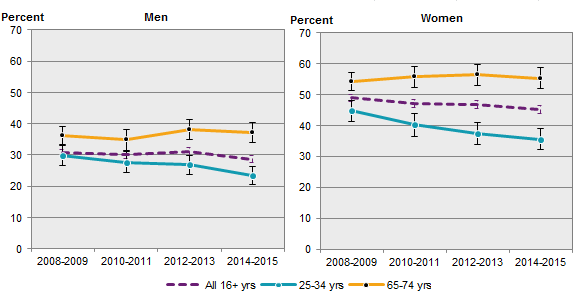Living Conditions Surveys (ULF/SILC):
Decreased book-reading among young adults
Statistical news from Statistics Sweden 2017-01-25 9.30
Fewer young adults read books today compared with 2008. Between 2008 and 2015, book-reading decreased among both men and women aged 25–34 years.
The percentage of the adult population aged 16 years and older who read a book every week declined among women from 49 percent to 45 percent in the period 2008–2015, while the percentage among men remained constant at 30 percent in the same period. On the other hand, among men in the age group 25–34 years, book-reading declined from 30 percent to 23 percent. Decreased book-reading is also apparent among women aged 25-34 years, from 45 percent in 2008 to 36 percent in 2015. Both young adult men and young adult women are now nearing the young people’s levels. Book-reading every week continues to be more common among women aged between 55 and 74 years, where the percentages have been around 56 percent in recent years, according to Statistics Sweden’s surveys on living conditions (ULF/SILC).

Listening to a book is not as widespread as reading a book in the traditional manner. It is estimated that 5.9 million men and women aged 16 and older, or 74 percent of the adult population, read a book at least once during a year, while 1.6 million, or 20 percent, listen to a book.
There is nothing in the surveys on living conditions (ULF/SILC) to show that groups that read books to a small extent listen to books instead. More than six out of ten men and eight out of ten women aged between 16 and 29 years read a book occasionally, while the proportion of those who listen to a book occasionally is only two out of ten, both among young men and young women.
Older people are increasingly active in sports
The ULF/SILC surveys measure welfare in a broad perspective and include several data on leisure activities. The statistics show a sharp increase in exercising and practising sports among older people in the period 2008–2015. In the age group 75–84 years, the percentage of those who practised sports or exercised every week increased from 34 percent to 61 percent among men, and from 32 percent to 58 percent among women.
More than half of the 16–19 year-olds went skating in 2014–2015, while one in four of them went cross-country skiing. One in twenty people aged 65–79 years went skating, while one in eight people went cross-country skiing.
Definitions and explanations
The data above is based on the following interview questions:
Book-reading:
“During the last 12 months, have you read books in your leisure time?” (Not audio books).
If yes: “Have you read books by and large every week or less often?”
1: Every week (one or more times)
2: Less often
Listening to books:
“Have you listened to books in your leisure time?” (In the last 12 months.) Yes/No
Exercise, sports and outdoor activities:
“Have you exercised or taken part in outdoor sports during the last 12 months?”
“Have you taken part in indoor sports or exercised at an indoor facility during the last 12 months?”
If Yes:
“How many times or how often (during the last 12 months)?”
1 A few times during the last three months or less often (1–5 times)
2 A few times a month (6–20 times)
3 A few times a week or more often (more than 20 times)
Have you (in the last 12 months):
“Gone cross-country skiing?” Yes/No
“Gone skating?” Yes/No
Publication
More information on leisure activities in the population is available in the recently published report Leisure 2014–2015. A more extensive collection of tables (in Excel, available only in Swedish) has been published in connection with the report.
More information
In addition to leisure time activities, statistics is also available about housing, finances, health, material assets, civic activities, social relations, employment, working environment and security.
Next publishing will be
2017-04-26
Statistical Database
More information is available in the Statistical Database
Feel free to use the facts from this statistical news but remember to state Source: Statistics Sweden.
